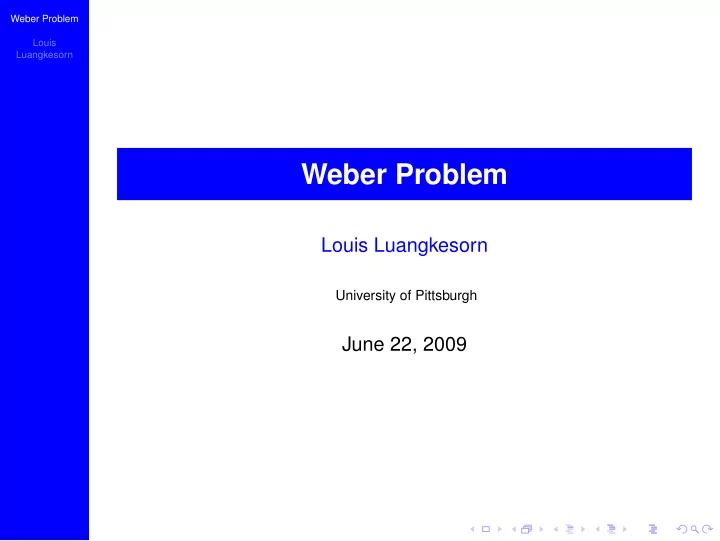

Weber Problem Louis Luangkesorn Weber Problem Louis Luangkesorn University of Pittsburgh June 22, 2009
Weber Problem Introduction to the Weber Problem Louis Luangkesorn Weber Problem: Find the "minimum" point ( x ∗ , y ∗ ) which minimizes the sum of weighted distances from itself to n fixed points with co-ordinate ( a i . b i ), where each point i has a weight w i
Weber Problem Formulation of Weber Problem Louis Luangkesorn n � min x , y { W ( x , y ) = w i d i ( x , y ) } t = 1 � ( x − a i ) 2 + ( y − b i ) 2 ) d i ( x , y ) =
Weber Problem Solving the Weber Problem Geometrically Louis Luangkesorn • The Varignon Frame. • This works because it is essentially the dual of the linear programming formulation. • The vector ( u i , v i ) is the negative of the force vector exerted on the knot by weight w i .
Weber Problem Dual of the Weber problem Louis Luangkesorn n � ( U , V ) D ( U , V ) = − max ( a i u i + b i v i ) i = 1 s.t. � n i = 1 u i = 0 � n i = 1 v i = 0 � u 2 i + v 2 i ≤ w i (1)
Weber Problem Weiszfield Algorithm Louis Luangkesorn • Take derivitive of the objective function and set to 0 • Start with a candidate solution • Determine next iteration • repeat until convergence • Note: can have problems if a candidate location is one of the fixed point. (Because the algorithm will only approach the fixed point.) n dW ( x , y ) w i ( x − a i ) � = = 0 dx d i ( x , y ) i = 1 dW(x,y) wi ( y − bi ) dy = P n di ( x , y ) = 0 i = 1 wi ai wi bi P n P n i = 1 di ( x ( k ) , y ( k ) ) i = 1 di ( x ( k ) , y ( k ) ) x ( k + 1 ) , y ( k + 1 ) = (2) , wi wi P n P n i = 1 i = 1 di ( x ( k ) , y ( k )) di ( x ( k ) , y ( k ) )
Weber Problem Centroid formulation Louis Luangkesorn • Minimizing sum of squared euclidean distances • This is the centroid n � w i d 2 min x , y C ( x , y ) = i ( x , y ) i = 1
Weber Problem Rectilinear distances Louis Luangkesorn Manhattan distance - only allow travel in a grid e.g. Roads in a grid layout n � w i d R min x , y R ( x , y ) = i ( x , y ) i = 1 d R i ( x , y ) = | x − a i | + | y − b i |
Weber Problem p -norm Distance Louis Luangkesorn • p -norm are generalizations of Euclidean distances | x − a i | p + | y − b i | p � p l pi = (3)
Weber Problem Multiple Facilities Louis Luangkesorn • Where m new facilities will be placed and one new facility y • Weights between facility j and demand point i is w ij • Weights between facility j and demand point s is v js n m � � � ( x j − a i ) 2 + ( y j − b i ) 2 + min w ij ( x , y ) j = 1 ,... () , m i = 1 j = 1 � m − 1 � m ( x j − a s ) 2 + ( y j − b s ) 2 � s = j + 1 v js j = 1
Weber Problem Restricted regions Louis Luangkesorn • Forbidden regions - Cannot locate in F • min x , y F ( x , y ) = � n i = 1 w i d i ( x , y ) • Barriers - Path cannot cross B • min x , y B ( x , y ) = � n i = 1 w i d B i ( x , y )
Weber Problem Point along line Louis Luangkesorn • Locate a line l which is as close as possible to the set of points • min linesl L ( l ) = � n i = 1 w i γ i ( l ) • γ i ( l ) is the closest distance to point i to line l
Recommend
More recommend